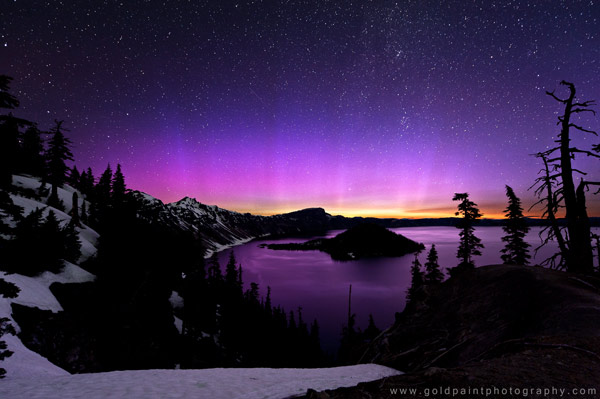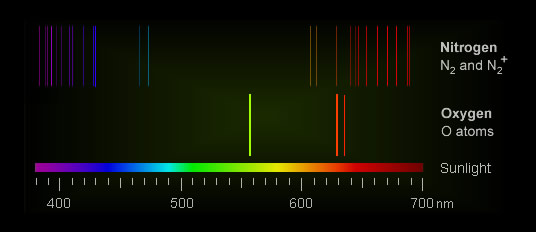Create a free profile to get unlimited access to exclusive videos, sweepstakes, and more!
Aurora, in the pink

'Tis the season for solar storms, and I'm hearing reports that Active Region 1504 (the same sunspot featured in a dramatic video I posted recently) has been getting feisty, blowing out some flares and causing auroral activity here on Earth.
Photographer Brad Goldpaint was in the right place at the right time Saturday night to see some of this: He went to Crater Lake, Oregon, and at 3:30 a.m. local time on June 17 he took this surpassingly beautiful picture of a somewhat rare event: pink aurorae!
[Click to recombinate.]
Gorgeous! And weird. The colors you see in aurorae depend mostly on what's in the air. Literally! A solar storm is an eruption of subatomic particles launched from the Sun at high speed. These interact with the Earth's magnetic field, which, through a complicated process, sends those little beasties down into our air. They slam into the molecules and atoms in the upper atmosphere, blasting off electrons like bullets hitting concrete and sending out shrapnel.
When electrons recombine with the atoms and molecules, a little bit of energy is released in the form of light, and the color of that light depends on what's doing the emitting. Oxygen atoms, for example, tend to glow green and/or red. Oxygen molecules (two atoms combined, like the kind we breathe) glow blue. Nitrogen molecules can glow either red or blue. Here's a diagram from the excellent Atmospheric Optics website:
As you can see, several colors are emitted by the various atoms and molecules. One color you won't see there, though, is pink. That's because pink isn't a spectral color; that is, part of the ROYGBIV red-orange-yellow-green-blue-indigo-violet spectrum.
 If you have a source of red and blue light, these can combine to make something look magenta or pink, as in the diagram here. I strongly suspect that's what's going on here; we're seeing a combination of red and blue light emitted by nitrogen molecules high over the Earth, and our eyes see that balance as pink. Cameras are designed to see colors much the way our eyes do, so the aurora looks pink in pictures as well.
If you have a source of red and blue light, these can combine to make something look magenta or pink, as in the diagram here. I strongly suspect that's what's going on here; we're seeing a combination of red and blue light emitted by nitrogen molecules high over the Earth, and our eyes see that balance as pink. Cameras are designed to see colors much the way our eyes do, so the aurora looks pink in pictures as well.
Pink aurorae aren't unknown, but it is rare to see the color this strongly with no almost no other coloring at all. And of course, Brad's photographic skills are excellent, so it's not just the color but the scene itself in his photo that is so breathtaking. He has another shot he took that night, too. Crater Lake is one of my favorite places on Earth, and if you've never been, go! If you time it well, you may be mesmerized not just by the Earth below, but by the heavens above as well.
Image credits: Brad Goldpaint (used by permission); Atmospheric Optics; Wikipedia
Related Posts:
- The softly glowing night sky
- Meteor, crater
- Rekindled flame
- The skies reflect our spinning world




























